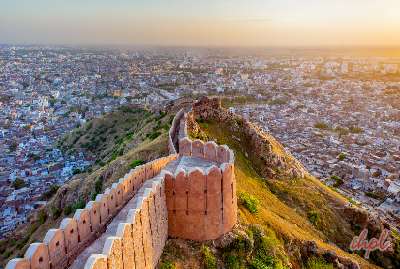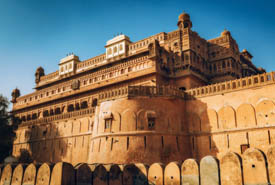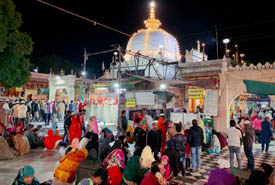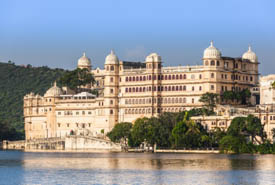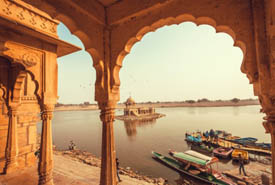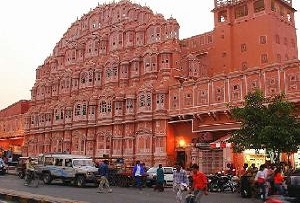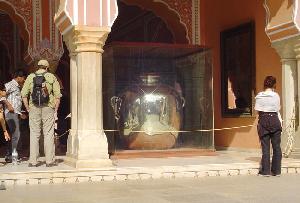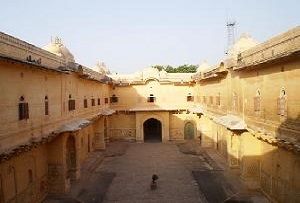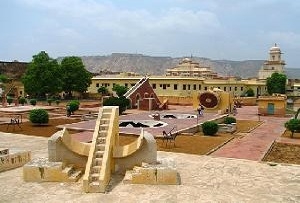Location: Gangori Bazaar, J.D.A. Market
Timings: 9:00 am to 4:30 pm
Visit Duration: 1 Hour
Entry Fee: ₹50 For Indians and ₹200 For Foreigners
Planning a Trip? Speak to an expert
Jantar Mantar, a UNESCO World Heritage Site, is a popular tourist attraction in Jaipur. It houses 19 of the world’s best astronomical instruments, including the Samrat Yantra, Jaiprakash Yantra, and Hindu Chhatri. These instruments were used to measure time, track celestial bodies, and observe the orbits of the planets around the sun. The observatory has an Interpretation Center where visitors can learn about the instruments and their significance.
For a detailed understanding of what Jaipur has to offer, check out our Jaipur Tour Packages and Detailed Jaipur Guide.
Jantar Mantar History
The Rajput king Maharaja Sawai Jai Singh built Jaipur’s Jantar Mantar in the 18th century. It was designated a UNESCO World Heritage Site in 2010. This observatory is renowned for its unique architecture and historical importance. Construction of the Jantar Mantar was completed in 1734 and is located near the Hawa Mahal. There are five Jantar Mantars in India: Delhi, Jaipur, Ujjain, Mathura, and Varanasi.
Jantar Mantar Architecture
Jantar Mantar architecture combines Indian and Islamic influences. The instruments are made from marble and stone, and their precision construction makes them ideal for astronomical observations. This observatory displays the time’s scientific and mathematical prowess.
Major Attractions Within Jantar Mantar
Here are some of the instruments and attractions within the complex:
Vrihat Samrat Yantra: This is the world’s largest stone sundial, standing 88 feet tall. It is designed to measure time with an accuracy of about two seconds using a massive triangular gnomon.
Laghu Samrat Yantra: Like the Vrihat Samrat Yantra, this sundial measures time on a smaller scale, providing accurate readings for shorter periods.
Ram Yantra: It consists of two cylindrical structures open to the sky and is used to measure the altitude and azimuth of celestial objects.
Jaya Prakash Yantra: This Yantra consists of two hemispherical bowls and is used to locate celestial objects. The instrument is particularly useful for validating other observatory instruments.
Chakra Yantra: It was used to determine the right ascension and declination of celestial bodies.
Digamsa: Celestial bodies are measured using this instrument to determine their horizontal position relative to the observer.
Rasivalya: It is used for astrological research to measure zodiac signs’ latitudes.
Nadivalaya: It was used to determine the time based on the sun’s position. There are two circular plates: one representing the northern hemisphere and one representing the southern hemisphere.
Karnti Vritya: This instrument was used to determine solar declination and visualise the sun’s apparent movement across the sky.
Bhairav Temple: After exploring all the yantras, you should visit the temple at the complex’s exit gate.
Jantar Mantar Entry And Timings
Jantar Mantar Jaipur is open to visitors from 9:00 a.m. to 4:30 p.m. It is recommended that visitors visit in the morning to avoid crowds and the heat of the sun.
Jantar Mantar Ticket Price
- Entry fee: INR. 50 for Indians and INR 200 for foreigners.
- Check the official website for updated timings and fees before visiting.
How To Reach Jantar Mantar
- To reach Jantar Mantar, arrive at Jaipur’s railway station, airport, or bus stop.
- You can take a taxi, bus, or auto-rickshaw to your destination.
Best Time To Visit Jantar Mantar
- The best time to visit Jantar Mantar Jaipur is during the winter months, from October to March.
- Summers can be harsh, with temperatures rising up to 48°C.
- If visiting in the summer, plan your trip for early morning or evening to avoid the intense heat.
Places to visit Near Jantar Mantar
If you’re planning to visit Jantar Mantar, here are some nearby places and monuments in Jaipur which you can explore as well:
- Hawa Mahal (700 m – 5 minutes)
- City Palace (100 m – 3 minutes)
- Albert Hall Museum (3 km – 11 minutes)
- Nahargarh Fort (13.7 km – 34 minutes)
- Amber Fort (7.6 km – 20 minutes)
For more insights into things to do and places to visit in Jaipur, explore our places to visit in Jaipur and things to do in Jaipur pages.
Jaipur Tour Packages
Things To Do in Jaipur
- Rajasthan Tour Packages
- Rajasthan Tourism
- Best Time to Visit Rajasthan
- How to Reach Rajasthan
- Cities In Rajasthan
- Ajmer Tourism
- Accommodation in Ajmer
- History of Ajmer
- Alwar Tourism
- History of Alwar
- Accommodation in Alwar
- Banswara Tourism
- Baran Tourism
- Bharatpur Tourism
- Bikaner Tourism
- Shopping in Bikaner
- Bundi Tourism
- Chittorgarh Tourism
- Dungarpur Tourism
- Ganganagar Tourism
- Ghanerao Tourism
- Hanumangarh Tourism
- Jaipur Tourism
- Arts and Crafts in Jaipur
- Jaipur Temperature
- Cuisine in Jaipur
- Entertainment in Jaipur
- History of Jaipur
- Jaisalmer Tourism
- History of Jaisalmer
- Jhalawar Tourism
- Jodhpur Tourism
- Entertainment in Jodhpur
- History of Jodhpur
- Khimsar Tourism
- Kota Tourism
- Mandawa Tourism
- History of Mandawa
- Mount Abu Tourism
- History of Mount Abu
- Pushkar Tourism
- Udaipur Tourism
- Entertainment in Udaipur
- History of Udaipur
- Rohet Tourism
- Samode Tourism
- Sawai Madhopur Tourism
- Shekhawati Tourism
- Gangaur Festival, Jaipur
- Jaipur Literature Festival
- Teej Festival in Jaipur
- Rajasthan International Folk Festival
- Pushkar Fair 2024
- Fairs and Festivals in Rajasthan
- Alwar Festival Rajasthan
- Baneshwar Fair Dungarpur, Rajasthan
- Banganga Fair
- Brij Festival Bharatpur
- Bundi Utsav in Rajasthan
- Camel Festival in Bikaner
- Chandrabhaga Fair Jalawar, Rajasthan
- Jaisalmer Desert Festival
- Flamenco & Gypsy Festival in Jodhpur
- Gogamedi Fair Rajasthan
- Holi in Rajasthan
- International Kite Festival Jaipur
- Kaila Devi Fair
- Kajli Teej Festival Bundi, Rajasthan
- Kalbelia Dance Festival Rajasthan
- Kallaji Fair Banswara, Rajasthan
- Karni Mata Mela Bikaner
- Kolayat Fair Bikaner
- Mahaveerji Fair Rajasthan
- Marwar Festival Jodhpur
- Mewar Festival Udaipur
- Nagaur Fair Rajasthan
- Shekhawati Festival Rajasthan
- Shilpgram Mela Udaipur
- Summer Festival in Mount Abu
- Teej Festival Jaipur
- Winter Festival Mount Abu
- Udaipur World Music Festival
- Adventure Activities in Rajasthan
- Art and Crafts in Rajasthan
- Bhavai Dance of Rajasthan
- Block Printing Rajasthan
- Blue Pottery Rajasthan
- Dandiya Dance Rajasthan
- Enamel Jewellery of Rajasthan
- Fresco Paintings Rajasthan
- Ghoomar Dance Rajasthan
- Jaipuri Quilt (Razai)
- Kachi Ghodi Dance Rajasthan
- Kathputli Dance Rajasthan
- Maand Folk Music Rajasthan
- Pabuji Ki Phach Folk Music Rajasthan
- Folk Dances & Arts of Rajasthan
- Raagmala Paintings Rajasthan
- Art and Crafts of Rajasthan
- Silver Jewellery Rajasthan
- Terah Taal Dance Rajasthan
- Bandhej and Leheria Art- Tie & Dye Rajasthan
- Wood and Marble Carving Rajasthan
- Climate of Rajasthan
- Rajasthani Cuisine
- Influences on Rajasthani Cuisine
- Popular Rajasthani Delicacies
- Cultural Centers in Rajasthan
- Desert Cultural Center Jaisalmer
- Jawahar Kala Kendra Jaipur
- Rajasthan Culture and Tradition
- Entertainment in Rajasthan
- History of Rajasthan
- Luxury Trains in Rajasthan
- Night Life in Rajasthan
- Travel to Rajasthan by Air
- Travel to Rajasthan by Rail
- Travel to Rajasthan by Road
- Restaurants in Rajasthan
- Shopping in Rajasthan
- Sights in Rajasthan
- Tourist Attractions in Ajmer
- Places to Visit Near Ajmer
- Tour to Kishangarh
- Tour to Nasirabad
- Tour to Pushkar
- Forts and Palaces in Ajmer
- Akbar Palace & Museum in Ajmer
- Taragarh Fort in Ajmer
- Lakes and Gardens in Ajmer
- Ana Sagar Lake in Ajmer
- Subhash Bagh in Ajmer
- Monuments in Ajmer
- Adhai Din Ka Jhopra in Ajmer
- Mayo College Ajmer
- Museums in Ajmer
- Ajmer Government Museum
- Religious Places in Ajmer
- Ajmer Sharif Dargah
- Nasiyan Jain Temple
- Tourist Attractions in Alwar
- Bazaars in Alwar
- Bazaza Bazaar in Alwar
- Malakhera Bazaar in Alwar
- Excursions from Alwar
- Places to Visit in Kesroli
- Places to visit in Neemrana
- Forts and Palaces in Alwar
- Alwar Fort
- Bala Quila in Alwar
- City Palace in Alwar
- Vijay Mandir Palace in Alwar
- Lakes and Gardens in Alwar
- Siliserh Lake
- Historical Monuments in Alwar
- Bhangarh Fort in Alwar
- Moosi Maharani ki Chhatri
- Tomb of Fateh Jang in Alwar
- Museums in Alwar
- Alwar Government Museum in Alwar
- Temples in Alwar
- Bhartrihari Temple in Alwar
- Jain Temple in Alwar
- Shiva Temple in Alwar
- Places to Visit in Bharatpur
- Bharatpur Bird Sanctuary
- Excursions from Bharatpur
- Tour to Bandh Baretha
- Tour to Bayana
- Tour to Deeg Palace
- Tour to Kaman
- Tour to Roopvaas
- Lohagarh Fort Bharatpur
- Temples in Bharatpur
- Banke Bihari Temple in Bharatpur
- Ganga Maharani Temple Bharatpur
- Laxman Temple Bharatpur
- Tourist Attractions in Bikaner
- Bazaars in Bikaner
- Kote Gate Bikaner
- Places to Visit Near Bikaner
- Deshnok
- Tour to Kolayat
- Forts and Palaces in Bikaner
- Junagarh Fort
- Lallgarh Palace in Bikaner
- Monuments in Bikaner
- Devi Kund in Bikaner
- Museums in Bikaner
- Ganga Government Museum Bikaner
- Prachina Cultural Centre & Museum in Bikaner
- Temples in Bikaner
- Bhandasar Jain Temple Bikaner
- Deshnok Temple in Bikaner
- Shiv Bari Temple Bikaner
- Tourist Attraction in Bundi
- Shopping in Bundi
- Main Bazaar in Bundi
- Tour to Bijolia
- Forts and Palaces in Bundi
- Bundi Palace
- Sukh Mahal in Bundi
- Taragarh Fort Bundi
- Lakes and Gardens in Bundi
- Jait Sagar Lake in Bundi
- Nawal Sagar Lake in Bundi
- Raniji ki Baori in Bundi
- Monuments in Bundi
- Chaurasi Khambon Ki Chhatri in Bundi
- Dabhai Kund in Bundi
- Ratan Daulat in Bundi
- Tourist Attractions in Chittorgarh
- Shopping in Chittorgarh
- Fort Road Market Chittorgarh
- Rana Sanga Market Chittorgarh
- Sadar Bazaar Chittorgarh
- Excursions from Chittorgarh
- Forts and Palaces in Chittorgarh
- Chittorgarh Fort Rajasthan
- Fort Fateh Prakash Palace, Chittorgarh
- Padmini’s Palace Chittorgarh
- Rana Kumbha Palace Chittorgarh
- Gardens in Chittorgarh
- Chittorgarh Fort Gardens
- Padmini’s Gardens Chittorgarh
- Monuments in Chittorgarh
- Chhatris of Jaimal and Kalla Chittorgarh
- Kirti Stambh Chittorgarh
- Vijay Stambh Chittorgarh
- Museums in Chittorgarh
- Archeological Museum Chittorgarh
- Fateh Prakash Palace Museum Chittogarh
- Temples in Chittorgarh
- Kalika Mata Temple Chittorgarh
- Kumbha Shyam Temple Chittorgarh
- Meera Temple Chittorgarh
- Tourist Attractions in Dungarpur
- Tourist Attractions in Ghanerao
- Places to Visit in Jaipur
- Shopping in Jaipur
- Aravali Bazaar in Jaipur
- Bapu Bazaar in Jaipur
- Chandpole Bazar in Jaipur
- Gaurav Tower Bazaar in Jaipur
- Johari Bazaar in Jaipur
- Kishanpole Bazar in Jaipur
- Nehru Bazar in Jaipur
- Sireh Deori Bazaar in Jaipur
- Tibbati Bazaar in Jaipur
- Tripolia Bazaar in Jaipur
- Chokhi Dhani in Jaipur
- Excursion From Jaipur
- Forts in Jaipur
- Amber Fort
- City Palace in Jaipur
- Jaigarh Fort in Jaipur
- Nahargarh Fort, Jaipur
- Gardens in Jaipur
- Jai Niwas Garden in Jaipur
- Kanak Vrindavan Garden in Jaipur
- Ram Niwas Bagh in Jaipur
- Sisodia Rani ka Bagh, Jaipur
- Vidyadhar Garden Jaipur
- Monuments in Jaipur
- Gatore ki Chhatriyan Jaipur
- Hawa Mahal Jaipur
- Jal Mahal Jaipur
- Museums in Jaipur
- Albert Hall Museum Jaipur
- Birla Planetarium Jaipur
- City Palace Jaipur
- Dolls Museum Jaipur
- Wax Museum Jaipur
- Rambagh Golf Club
- Snow Planet Jaipur
- Temples in Jaipur
- Birla Temple Jaipur
- Galtaji Temple Jaipur
- Govind Dev Ji Temple Jaipur
- Moti Dungri Ganesh Ji Temple
- Tourist Attractions in Jaisalmer
- Shopping in Jaisalmer
- Bhatia Bazaar in Jaisalmer
- Sadar Bazaar in Jaisalmer
- Dune Bashing in Jaisalmer
- Places To Visit In And Around Jaisalmer
- Excursions from Jaisalmer to Barmer
- Excursions from Jaisalmer to Khichan
- Places to Visit in Pokhran
- Famous Forts in Jaisalmer
- Jaisalmer Fort
- Tazia Tower in Jaisalmer
- Gadsisar Lake in Jaisalmer
- Havelis in Jaisalmer
- Nathmal Ki Haveli in Jaisalmer
- Patwon ki Haveli in Jaisalmer
- Salim Singh ki Haveli
- Monuments and Havelis in Jaisalmer
- Museums in Jaisalmer
- Desert Culture Centre and Museum
- Quad Biking in Jaisalmer
- Sand Dunes in Jaisalmer
- Khuri Sand Dunes in Jaisalmer
- Sam Sand Dunes
- Temples in Jaisalmer
- Jain Temples in Jaisalmer
- Lakshminath Temple in Jaisalmer
- Lodurva Temple in Jaisalmer
- Places to Visit in Jodhpur
- Shopping in Jodhpur
- Kapra Bazaar in Jodhpur
- Mochi Bazaar in Jodhpur
- Sarafa Bazaar in Jodhpur
- Excursions from Jodhpur
- Flying Fox in Jodhpur
- Forts, Palaces and Cenotaphs in Jodhpur
- Mehrangarh Fort, Jodhpur
- Umaid Bhawan Palace in Jodhpur
- Gardens in Jodhpur
- Mandore Garden in Jodhpur
- Nehru Park in Jodhpur
- Umed Garden in Jodhpur
- Monuments in Jodhpur
- Jaswant Thada in Jodhpur
- Museums in Jodhpur
- Sardar Government Museum in Jodhpur
- Paragliding at Jodhpur
- Temples in Jodhpur
- Baba Ramdev Temple in Jodhpur
- Mahamandir Temple in Jodhpur
- Udai Mandir in Jodhpur
- Tourist Attractions in Kanota
- Tourist Attractions in Kota
- Main Bazaar Kota, Rajasthan
- Excursions from Kota
- Tour to Baroli
- Forts and Palaces in Kota
- City Fort Palace in Kota
- Jagmandir Palace Kota, Rajasthan
- Phool Sagar in Kota
- Taragarh Fort
- Lakes and Gardens in Kota
- Kesar Bagh in Kota
- Kishore Sagar Lake
- Sar Bagh in Kota
- Monuments and Havelis in Kota
- Haveli of Deaji
- Haveli of Devta Shridharji in Kota
- Museums in Kota
- Brij Vilas Palace Museum in Kota
- Raja Madho Singh Museum Kota
- Temples in Kota
- Kansua Temple Kota, Rajasthan
- Mathuradheesh Temple Kota
- Places to Visit in Mandawa
- Shopping in Mandawa
- Main Bazaar Mandawa
- Tour to Jhunjhunu
- Tour to Mukandgarh
- Tour to Ramgarh
- Forts in Mandawa
- Mandawa Fort Mandawa
- Monuments and Havelis in Mandawa
- Binsidhar Newatia Haveli Mandawa
- Goenka Chattri Mandawa
- Goenka Double Haveli Mandawa
- Gulab Rai Ladia Haveli
- Hanuman Prasad Goenka Haveli Mandawa
- Jhunjhunwala Haveli Mandawa
- Murmuria Haveli Mandawa
- Temples in Mandawa
- Thakurji Temple Mandawa
- Places to Visit in Mount Abu
- Shopping in Mount Abu
- Khadi Bazaar Mount Abu
- Forts and Palaces in Mount Abu
- Achalgarh Fort Mount Abu
- Kesar Bhawan Palace Mount Abu
- Sunrise Palace Mount Abu
- Lakes in Mount Abu
- Nakki Lake Mount Abu
- Monuments in Mount Abu
- Honeymoon Point in Mount Abu
- Sunset Point in Mount Abu
- The Crags Mount Abu
- Museums in Mount Abu
- Archeological Museum Mount Abu
- Brahma Kumaris Spiritual University and Museum Mount Abu
- Government Museum Mount Abu
- Temples in Mount Abu
- Adhar Devi Temple Mount Abu
- Dilwara Jain Temple Mount Abu
- Gaumukh Temple Mount Abu
- Luna Vashi Temple Mount Abu
- Mahaveer Swami Temple in Mount Abu
- Shri Raghunatji Temple Mount Abu
- Vimala Vashi Temple Mount Abu
- Tourist Attractions in Nawalgarh
- Places to Visit in Pushkar
- Bazaar in Pushkar
- Camel Safari in Pushkar
- Excursions from Pushkar
- Tour to Ajmer from Pushkar
- Tour to Kishangarh from Pushkar
- Tour to Kuchaman from Pushkar
- Tour to Roopangarh from Pushkar
- Forts and Palaces in Pushkar
- Man Mahal in Pushkar
- Pushkar Palace
- Pushkar Lake
- Temples in Pushkar
- Apteshwar Temple in Pushkar
- Brahma Temple in Pushkar
- Gayatri Mata Temple in Pushkar
- Mahadeva Temple in Pushkar
- Rangji Temple in Pushkar
- Raghunath Temple in Pushkar
- Sri Rama Vaikunth Temple in Pushkar
- Saraswati Temple in Pushkar
- Savitri Mata Temple in Pushkar
- Varaha Temple in Pushkar
- Best Places to Visit in Rajasthan
- Adventures Activities in Rajasthan
- Camping in Rajasthan
- Cycling in Rajasthan
- Hot Air Balloon Rides in Rajasthan
- Wildlife Safari in Rajasthan
- Forts & Palaces in Rajasthan
- Badnore Fort Bhilwara
- City Palace Karauli, Rajasthan
- Deogarh Mahal near Udaipur
- Dundlod Fort Jhunjhunu, Rajasthan
- Khimsar Fort Khimsar, Rajasthan
- Kumbhalgarh Fort
- Laxmangarh Fort Sikar, Rajasthan
- Madhogarh Fort Jaipur
- Mandalgarh Fort Bhilwara, Rajasthan
- Rohet Fort
- Deeg Palace, Bharatpur
- Havelis in Rajasthan
- Aath Haveli Nawalgarh, Rajasthan
- Anandilal Poddar Haveli Nawalgarh
- Bhagirath Mal Goenka Haveli Dundlod
- Bhagton ki Choti Haveli Nawalgarh
- Char Chowk Haveli Laxmangarh
- Chetram Sanganeeria Haveli Laxmangarh
- Chhauchharia Haveli Nawalgarh, Rajasthan
- Chokhani Double Haveli Mandawa
- Choudaharia Haveli Fatehpur
- Dharni Dhakra Haveli Nawalgarh
- Gauri Shankar Haveli Fatehpur
- Geevrajka Haveli Nawalgarh
- Harkishan Das Saraogi Haveli Fatehpur, Rajasthan
- Haveli Nadine Fatehpur, Rajasthan
- Hem Raj Kulwal Haveli Nawalgarh, Rajasthan
- Hira Lal Sarowgi Haveli
- Hodh Raj Patodia Haveli Nawalgarh
- Jagannath Singhania Haveli Fatehpur, Rajasthan
- Kaniram Narsinghdas Tibrewal Haveli Jhunjhunu
- Kanoria Haveli Mukandgarh
- Lakshminarayan Ladia Haveli Mandawa
- Mahaveer Prasad Goenka Haveli Fatehpur
- Mantri Haveli Churu, Rajasthan
- Modi Haveli Jhunjhunu, Rajasthan
- Mohan Lal Saraf Haveli Mandawa, Rajasthan
- Mohanlal Ishwardas Haveli Jhunjhunu, Rajasthan
- Muraraka Haveli Nawalgarh
- Narudin Farooqi Haveli Jhunjhunu
- Parusrampuria Haveli Nawalgarh
- Saraf Haveli Mukundgarh, Rajasthan
- Shyonarayan Kyal Haveli Laxmangarh, Rajasthan
- Sunheri Kothi Tonk, Rajasthan
- Vishnunath Keria Haveli Fatehpur, Rajasthan
- Hill Forts in Rajasthan
- Lakes & Gardens in Rajasthan
- Nehru Garden Udaipur
- Monuments in Rajasthan
- Ghanta Ghar Laxmangarh
- Hathi Bhata Tonk, Rajasthan
- Museums in Rajasthan
- Bharatiya Lok Kala Mandal in Udaipur
- Government Museum Jaisalmer
- Rajasthan State Archives Bikaner
- Udaipur Solar Observatory Udaipur
- Religious Sites in Rajasthan
- Achalgarh Shiva Temple Mount Abu
- Ambika Mata Temple Udaipur
- Charbhuja Mandir Bhilwara, Rajasthan
- Harni Mahadev Bhilwara Rajasthan
- Jain Temple Ranakpur
- Karni Mata Temple- Temple of Rats
- Laxminath Temple Bikaner
- Osiyan Temple Near Jodhpur
- Parshvanath Temple Nakoda, Rajasthan
- Radha Murlimanohar Temple Laxmangarh, Rajasthan
- Raj Ratan Bihari and Rasik Siromani Temple Bikaner
- Ranakpur Temple Udaipur
- Rani Sati Temple Jhunjhunu
- Rishabdevji Temple Dhulev, Rajasthan
- Satyanarayan Temple Dundlod
- Sawai Bhoj Temple Bhilwara, Rajasthan
- Shri Ramdev Temple
- Shrinathji Temple Nathdwara
- Safaris in Rajasthan
- Camel Safari in Rajasthan
- Horse Safari in Rajasthan
- Jeep Safari in Rajasthan
- Wildlife in Rajasthan
- Bharatpur Bird Sanctuary
- Places to Visit in Samode
- Shopping in Samode
- Main Bazaar Samode, Rajasthan
- Forts and Palaces in Samode
- Samode Fort Samode
- Samode Palace
- Gardens in Samode
- Samode Bagh
- Monuments and Havelis in Samode
- Samode Haveli
- Temples in Samode
- Govind Devji Temple Samode
- Lord Hanuman Temple Samode
- Mahadeva Temple Samode
- Tourist Attractions in Sariska
- Hanuman Temple Sariska
- Kankawadi Fort Sariska
- Tourist Attractions in Sawai Madhopur
- Forts in Sawai Madhopur
- Khandar Fort Sawai Madhopur
- Ranthambore Fort
- Ranthambore National Park
- Temples in Sawai Madhopur
- Chamatkar Temple Sawai Madhopur
- Chauth Mata Temple Sawai Madhopur
- Kala Gaura Bhairava Temple Sawai Madhopur
- Places to Visit in Udaipur
- Shopping in Udaipur
- Chetak Circle
- Excursions from Udaipur
- Forts and Palaces in Udaipur
- City Palace Udaipur
- Fateh Prakash Palace Udaipur
- Lake Palace Udaipur
- Shiv Niwas Palace Udaipur
- Lakes in Udaipur
- Fateh Sagar Lake Udaipur
- Jaisamand Lake Udaipur
- Lake Pichola Udaipur
- Rajsamand Lake in Udaipur
- Saheliyon ki Bari Udaipur
- Monsoon Palace Udaipur
- Monuments and Havelis in Udaipur
- Bagore ki Haveli Udaipur
- Maharana Pratap Memorial Udaipur
- Museums in Udaipur
- Ahar Museum Udaipur
- City Palace Museum Udaipur
- Shilpgram Museum Udaipur
- Temples in Udaipur
- Amba Mata Temple Udaipur
- Bohra Ganesh Temple Udaipur
- Eklingji Temple Udaipur
- Jag Mandir Palace Udaipur
- Jagat Ambika Mata Temple Udaipur
- Jagdish Temple Udaipur
- Kankroli Temple Udaipur
- Karni Mata Temple Udaipur
- Mahakaleshwar Temple Udaipur
- Mahalaxmi Temple Udaipur
- Meera Kala Mandir Udaipur
- Nathdwara Temple Udaipur
- Neemach Mata Temple Udaipur
- Shrinathji Temple Udaipur
- Ranakpur Temple Udaipur
- Rishabhdeo Temple Udaipur
- Sagas Ji Bavji Temple Udaipur
- Best time to visit Bharatpur Bird Sanctuary
- Best time to visit Ranthambore National Park







